-
 Iron tsuba of round form with design of military commander's fan (gunbai) in openwork (sukashi). Square rim. Hitsu-ana plugged with lead or tin. Ko-tosho school. Mid-Muromachi period (1454-1513), Entoku era (1489-92) / Meio era (1489-1501). Height: 80.3 mm, Width: 81.5 mm, Rim thickness: 3.0 mm. Centre thickness: 3.5 mm. Provenance: Sasano Masayuki Collection, №23 in Japanese Sword Guard Masterpieces from the Sasano Collection, 1994: Ko-tosho. Sukashi design: Military commander's fan (gunbai). Mid Muromachi period. Late 15th century (Entoku / Meio era). The military commander's fan (gunbai) was cherished by samurai warriors. This tsuba is relatively thick, with the large fan nicely positioned on the plate.
Iron tsuba of round form with design of military commander's fan (gunbai) in openwork (sukashi). Square rim. Hitsu-ana plugged with lead or tin. Ko-tosho school. Mid-Muromachi period (1454-1513), Entoku era (1489-92) / Meio era (1489-1501). Height: 80.3 mm, Width: 81.5 mm, Rim thickness: 3.0 mm. Centre thickness: 3.5 mm. Provenance: Sasano Masayuki Collection, №23 in Japanese Sword Guard Masterpieces from the Sasano Collection, 1994: Ko-tosho. Sukashi design: Military commander's fan (gunbai). Mid Muromachi period. Late 15th century (Entoku / Meio era). The military commander's fan (gunbai) was cherished by samurai warriors. This tsuba is relatively thick, with the large fan nicely positioned on the plate. -
 Iron tsuba of round form decorated with eight circular emblems of flowers and/or family crests (mon) made of cast brass, pierced and chiseled in kebori, as well as with flat brass inlay (hira-zōgan) of vines, leaves, and flowers all over the plate. Yoshirō school (Kaga-Yoshirō). The Momoyama or early Edo period, 17th century. Size: diameter 80 mm, thickness at seppa-dai 3,6 mm. Symbols: [12:00 o'clock] - Wood sorrel (katabami) and swords ; [9:00] - Cherry blossom (sakura); [7:30] - Bellflower (kikyō), kamon of Toki clan; [3:00] - possibly, a six-petal Chrysanthemum (kiku) or a Passion flower (tessen); [1:30] - Hemp (asanoha). The symbols at 6:00, 10:30, and 4:30 o'clock seem to be geometrical patterns of auspicious meaning: a cross in a square, a four pointing star, and a diamond, respectively. Alternatively, we may look at this piece as purely decorative, with patterns at 12:00, 3:00, 6:00, and 9:00 o'clock in negative openwork (in-sukashi), and at 1:30, 4:40, 7:20, and 10:30 o'clock - in positive openwork (ji-sukashi, or yō-sukashi). Markus Sesko in his Handbook of sword fittings related terms [Herstellung und Verlag: Books on Demand GmbH, Norderstedt, 2011] discriminates this type of openwork in a separate class: Ranma-sukashi: "This term is applied to circular sukashi with family crests to their inside, which are arranged running along the rim area. The description goes back to the opened boards (ranma) between the sliding doors and the ceiling of Japanese rooms. Ranma-sukashi are mostly seen on old Heianjō- or Yoshirō-zōgan-tsuba but also on works of Hayashi Matashichi" [page 30].
Iron tsuba of round form decorated with eight circular emblems of flowers and/or family crests (mon) made of cast brass, pierced and chiseled in kebori, as well as with flat brass inlay (hira-zōgan) of vines, leaves, and flowers all over the plate. Yoshirō school (Kaga-Yoshirō). The Momoyama or early Edo period, 17th century. Size: diameter 80 mm, thickness at seppa-dai 3,6 mm. Symbols: [12:00 o'clock] - Wood sorrel (katabami) and swords ; [9:00] - Cherry blossom (sakura); [7:30] - Bellflower (kikyō), kamon of Toki clan; [3:00] - possibly, a six-petal Chrysanthemum (kiku) or a Passion flower (tessen); [1:30] - Hemp (asanoha). The symbols at 6:00, 10:30, and 4:30 o'clock seem to be geometrical patterns of auspicious meaning: a cross in a square, a four pointing star, and a diamond, respectively. Alternatively, we may look at this piece as purely decorative, with patterns at 12:00, 3:00, 6:00, and 9:00 o'clock in negative openwork (in-sukashi), and at 1:30, 4:40, 7:20, and 10:30 o'clock - in positive openwork (ji-sukashi, or yō-sukashi). Markus Sesko in his Handbook of sword fittings related terms [Herstellung und Verlag: Books on Demand GmbH, Norderstedt, 2011] discriminates this type of openwork in a separate class: Ranma-sukashi: "This term is applied to circular sukashi with family crests to their inside, which are arranged running along the rim area. The description goes back to the opened boards (ranma) between the sliding doors and the ceiling of Japanese rooms. Ranma-sukashi are mostly seen on old Heianjō- or Yoshirō-zōgan-tsuba but also on works of Hayashi Matashichi" [page 30]. -
 Iron tsuba of round form decorated with eight roundels – circular emblems of flowers and/or family crests (mon) made of cast brass, pierced and chiseled in kebori, and with flat brass inlay (hira-zōgan) of vines or leaves all over the plate. Both hitsu-ana trimmed in brass. Nakago-ana of rectangular form, with copper sekigane. Four positive openwork (ji-sukashi) roundels at 12, 3, 6, and 9 o'clock; and four negative openwork (in-sukashi) roundels with cherry blossom, bellflower, and two variations on suhama theme. Yoshirō school (Kaga-Yoshirō). The Momoyama or early Edo period, late 16th to early 17th century. Size: diameter 81.4 mm, thickness 4.7 mmat seppa-dai, 4.0 mm at rim. Christie's lot description: AN IRON TSUBA; EDO PERIOD (17TH CENTURY). THE DOLPHYN COLLECTION OF SAMURAI ART. The round iron tsuba pierced with roundels of various floral motifs interspersed among scrolling foliage, all inlaid with brass. 8.1 cm. high. Provenance: Pabst Collection (no. 338).
Iron tsuba of round form decorated with eight roundels – circular emblems of flowers and/or family crests (mon) made of cast brass, pierced and chiseled in kebori, and with flat brass inlay (hira-zōgan) of vines or leaves all over the plate. Both hitsu-ana trimmed in brass. Nakago-ana of rectangular form, with copper sekigane. Four positive openwork (ji-sukashi) roundels at 12, 3, 6, and 9 o'clock; and four negative openwork (in-sukashi) roundels with cherry blossom, bellflower, and two variations on suhama theme. Yoshirō school (Kaga-Yoshirō). The Momoyama or early Edo period, late 16th to early 17th century. Size: diameter 81.4 mm, thickness 4.7 mmat seppa-dai, 4.0 mm at rim. Christie's lot description: AN IRON TSUBA; EDO PERIOD (17TH CENTURY). THE DOLPHYN COLLECTION OF SAMURAI ART. The round iron tsuba pierced with roundels of various floral motifs interspersed among scrolling foliage, all inlaid with brass. 8.1 cm. high. Provenance: Pabst Collection (no. 338). -
 Iron tsuba of round form decorated with design of pine tree mushrooms (matsutake) in openwork (sukashi). Hitsu-ana of elongated oval form. Raised rim (mimi) with iron bones (tekkotsu). Copper sekigane. Size: 84.5 mm x 85.1 mm; thickness: 3.0 mm (center), 5.6 mm (rim). Mid Muromachi period, 15th century. The shape and width of the rim, as well as the shape of the hitsu-ana, argue for earlier Muromachi. Tsuba is slightly wider than high, that might suggest middle of Muromachi age. According to Robert Haynes, circa 1450-1500.
Iron tsuba of round form decorated with design of pine tree mushrooms (matsutake) in openwork (sukashi). Hitsu-ana of elongated oval form. Raised rim (mimi) with iron bones (tekkotsu). Copper sekigane. Size: 84.5 mm x 85.1 mm; thickness: 3.0 mm (center), 5.6 mm (rim). Mid Muromachi period, 15th century. The shape and width of the rim, as well as the shape of the hitsu-ana, argue for earlier Muromachi. Tsuba is slightly wider than high, that might suggest middle of Muromachi age. According to Robert Haynes, circa 1450-1500. -
 Iron tsuba of slightly elongated round form decorated with design of melon flowers, vines, and leaves in brass flat inlay (hira-zōgan) on both sides. Slightly raised rim (mimi) carved in a way to simulate ring-shaped covering (fukurin). Kozuka hitsu-ana and kogai hitsu-ana both plugged with soft metal (tim or lead). Copper sekigane. Heianjō or Kaga School. Muromachi or Momoyama period, 16th century. Iron, hira-zōgan brass inlay. Round (maru gata) form, diameter 79 mm. Size: 80.3 x 78.4 mm; thickness at seppa-dai: 3.4 mm; at the middle: 3.8 mm; before the rim: 2.4 mm, rim: 2.8 mm. Note on design: though this design resembles family crests with oak and mulberry leaves, I believe it's a melon flower [see Jeanne Allen. Designer's guide to Samurai Patterns. Chronicle Books, San Francisco, 1990, page 114, №130 "Melon Flowers":Note about the distribution of thickness (niku-oki): "this tsuba has toroid features, niku raises from the rim towards the centre but thins once more out when approaching the seppa-dai" [M. Sesko, "Handbook...", p. 48].
Iron tsuba of slightly elongated round form decorated with design of melon flowers, vines, and leaves in brass flat inlay (hira-zōgan) on both sides. Slightly raised rim (mimi) carved in a way to simulate ring-shaped covering (fukurin). Kozuka hitsu-ana and kogai hitsu-ana both plugged with soft metal (tim or lead). Copper sekigane. Heianjō or Kaga School. Muromachi or Momoyama period, 16th century. Iron, hira-zōgan brass inlay. Round (maru gata) form, diameter 79 mm. Size: 80.3 x 78.4 mm; thickness at seppa-dai: 3.4 mm; at the middle: 3.8 mm; before the rim: 2.4 mm, rim: 2.8 mm. Note on design: though this design resembles family crests with oak and mulberry leaves, I believe it's a melon flower [see Jeanne Allen. Designer's guide to Samurai Patterns. Chronicle Books, San Francisco, 1990, page 114, №130 "Melon Flowers":Note about the distribution of thickness (niku-oki): "this tsuba has toroid features, niku raises from the rim towards the centre but thins once more out when approaching the seppa-dai" [M. Sesko, "Handbook...", p. 48].
Jeanne Allen. Designer's guide to Samurai Patterns. Chronicle Books, San Francisco, 1990. Page 114, №130.
-
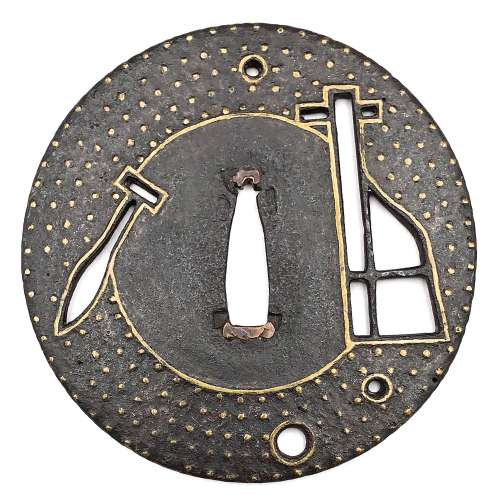 Iron tsuba of round form with design of rudder, paddle, and stars in small openwork (ko-sukshi) outlined with brass wire, and further decorated with inlay of five concentric rows of brass dots or nail heads (ten-zōgan) and circular brass wire inlaid inside the innermost row of dots. Two lower round openings may also serve as udenuki-ana. Copper sekigane. Unsigned. Late Muromachi or Momoyama period, 16th century. Diameter: 90.4 x 89.8 x 2.8 mm.
Iron tsuba of round form with design of rudder, paddle, and stars in small openwork (ko-sukshi) outlined with brass wire, and further decorated with inlay of five concentric rows of brass dots or nail heads (ten-zōgan) and circular brass wire inlaid inside the innermost row of dots. Two lower round openings may also serve as udenuki-ana. Copper sekigane. Unsigned. Late Muromachi or Momoyama period, 16th century. Diameter: 90.4 x 89.8 x 2.8 mm. -
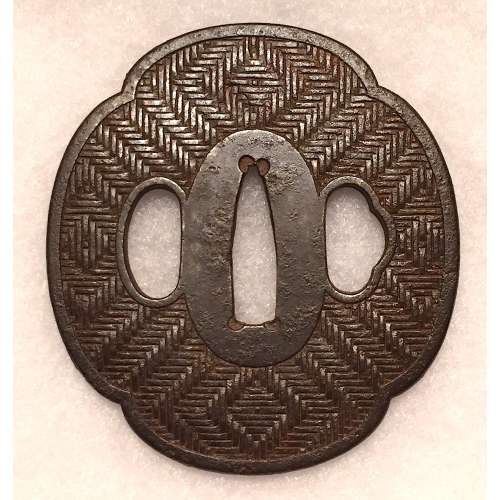 Iron tsuba with brown patina in mokkō-gata form with woven design. Size: 72 x 67 x 5 mm.
Iron tsuba with brown patina in mokkō-gata form with woven design. Size: 72 x 67 x 5 mm. -

Fuchi-kashira made of shakudō carved and inlaid with gold and red copper with the design of a bat and a fruit (persimmon?). Nanako surface.
Fuchi: 37 x 19 x 7 mm. Kashira: 34 x 16 x 5 mm. Main material: shakudō. Other metals: gold and copper. Surface treatment: nanako-ji. -
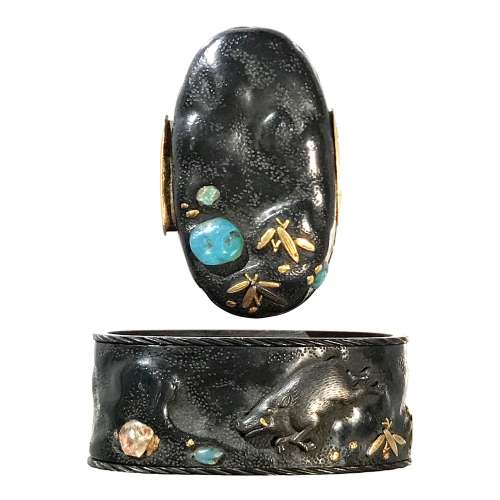 Signature: Unsigned
Signature: UnsignedFuchi-kashira with rock and boar (iwa ni inoshishi zu) motif. Inlay of precious stones or colour glass. Shakudō, gold, gemstones. Technique: Sukibori zogan kiniroe.
Fuchi: 36 x 21 x 14 mm; Weight: 22 g; Kashira: 32 x 17 x 5 mm; Weight: 8 g; Material : Shakudō; Gold; Gemstones (Chalcedony and Rose Quartz). Possibly, Owari school. -
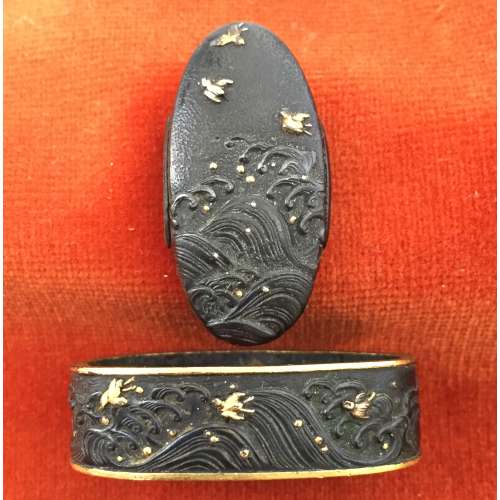 Fuchi: 37 x 21 x 11 mm; Weight: 13 g Kashira: 34 x 16 x 6 mm ; Weight: 10 g Material : Shakudo; Gold. Signature: Unsigned Technique: Sunameji Sukibori Zogan Decoration: Nami Chidori zu (wave & plover)
Fuchi: 37 x 21 x 11 mm; Weight: 13 g Kashira: 34 x 16 x 6 mm ; Weight: 10 g Material : Shakudo; Gold. Signature: Unsigned Technique: Sunameji Sukibori Zogan Decoration: Nami Chidori zu (wave & plover) -
 Fuchi: 38 x 22 x 12 mm. Kashira: 32 x 17 x 11 mm Main material: shakudo; surface treatment: nanako-ji; other metals: gold, shibuichi and copper; decorative technique: iroe takazogan. Signed: Nyudo Jounishi 人道 乗西 (possibly)
Fuchi: 38 x 22 x 12 mm. Kashira: 32 x 17 x 11 mm Main material: shakudo; surface treatment: nanako-ji; other metals: gold, shibuichi and copper; decorative technique: iroe takazogan. Signed: Nyudo Jounishi 人道 乗西 (possibly) -
 Fuchi: 38 x 22 x 14 mm. Kashira: 33 x 18 x 9 mm Techniques: Usu-shishiai-bori (薄肉合彫) – low-relief, zogan.
Fuchi: 38 x 22 x 14 mm. Kashira: 33 x 18 x 9 mm Techniques: Usu-shishiai-bori (薄肉合彫) – low-relief, zogan. -
 Fuchi-kashira of copper, carved and inlaid with gold and shakudō, with the design of Kanzan (on kashira), Chinese: Hanshan, an eccentric poet of the Tang dynasty with a scroll (618-906) who befriended Jittoku (on fuchi, Chinese: Shide, a kitchen helper at a mountain temple, holding a broom). Fuchi is signed Josui (如⽔). Fuchi (Jittoku, holding a broom): 38 x 22 x 12 mm. Weight: 23g (Nakago hole: 27 x 8.5 mm); Kashira (Kanzan, reading a scroll): 34 x 17 x 9 mm. Weight: 10g. Materials: Copper, gold, shakudō. Techniques: Tsuchi-me-ji (hammer-marked surface); usu-shishiai-bori or usuniku-bori (low-relief carving which leaves the image somewhat higher than the surface - high relief effect); zōgan (inlay). Josui was a daughter of Jochiku Kamo (Markus Sesko, Genealogies).
Fuchi-kashira of copper, carved and inlaid with gold and shakudō, with the design of Kanzan (on kashira), Chinese: Hanshan, an eccentric poet of the Tang dynasty with a scroll (618-906) who befriended Jittoku (on fuchi, Chinese: Shide, a kitchen helper at a mountain temple, holding a broom). Fuchi is signed Josui (如⽔). Fuchi (Jittoku, holding a broom): 38 x 22 x 12 mm. Weight: 23g (Nakago hole: 27 x 8.5 mm); Kashira (Kanzan, reading a scroll): 34 x 17 x 9 mm. Weight: 10g. Materials: Copper, gold, shakudō. Techniques: Tsuchi-me-ji (hammer-marked surface); usu-shishiai-bori or usuniku-bori (low-relief carving which leaves the image somewhat higher than the surface - high relief effect); zōgan (inlay). Josui was a daughter of Jochiku Kamo (Markus Sesko, Genealogies). -
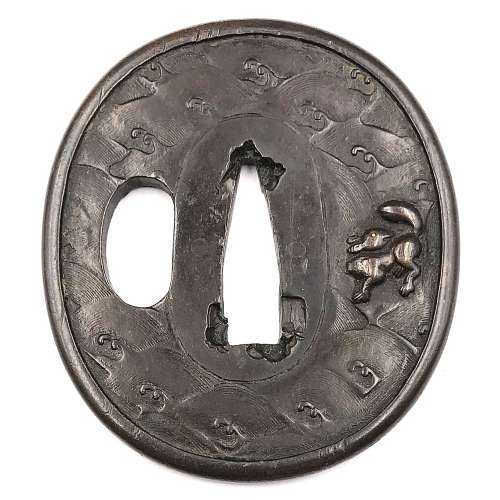 Ko-kinko ymagane cast tsuba of oval form with chiseled diaper pattern of double head waves on both sides and a rabbit cast and carved with its eye inlaid in yellow metal (gold or brass) on the face. Fukurin which holds together the sandwiched layers of metal (sanmai) is about 2.7 mm wide. Possibly, early Mino (ko-Mino) school. Size: 66.6 x 59.9 x 4.0 mm. Some connoisseurs believe that this kind of tsuba was in mass production at the time. Small animal believed to be a fox, however some attribute it to a long-tailed rabbit or a squirrel. I am leaning towards the rabbit. Similar example is found at Robert E. Haynes Catalog №3, April 9-11, 1982 on page 11, under № 15: “Rare design in style of Sanmai (three layers) / Wasei work. With yamagane core and heavy rim cover. The web plates are carved with double head Goto style waves and the face has a fox. The web plates were riveted at the seppadai. See Lot 4, page 8. Ca. 1350. Ht. 6.6 cm, th. 3 mm” [underscore mine]. Quality of photo is so poor that I decided not to provide it here. The only difference betwen my tsuba and his is that his has a square hole on the right shoulder of the seppa-dai. Early Muromachi (if we follow Robert it is even Nanbokucho, 1337-1392) or Momoyama period. The Momoyama attribution is mostly based on a fact that “waves and rabbit” motif became most popular in Momoyama times. Mokkōgata tsuba of similar design in this collection - see TSU-0282.
Ko-kinko ymagane cast tsuba of oval form with chiseled diaper pattern of double head waves on both sides and a rabbit cast and carved with its eye inlaid in yellow metal (gold or brass) on the face. Fukurin which holds together the sandwiched layers of metal (sanmai) is about 2.7 mm wide. Possibly, early Mino (ko-Mino) school. Size: 66.6 x 59.9 x 4.0 mm. Some connoisseurs believe that this kind of tsuba was in mass production at the time. Small animal believed to be a fox, however some attribute it to a long-tailed rabbit or a squirrel. I am leaning towards the rabbit. Similar example is found at Robert E. Haynes Catalog №3, April 9-11, 1982 on page 11, under № 15: “Rare design in style of Sanmai (three layers) / Wasei work. With yamagane core and heavy rim cover. The web plates are carved with double head Goto style waves and the face has a fox. The web plates were riveted at the seppadai. See Lot 4, page 8. Ca. 1350. Ht. 6.6 cm, th. 3 mm” [underscore mine]. Quality of photo is so poor that I decided not to provide it here. The only difference betwen my tsuba and his is that his has a square hole on the right shoulder of the seppa-dai. Early Muromachi (if we follow Robert it is even Nanbokucho, 1337-1392) or Momoyama period. The Momoyama attribution is mostly based on a fact that “waves and rabbit” motif became most popular in Momoyama times. Mokkōgata tsuba of similar design in this collection - see TSU-0282.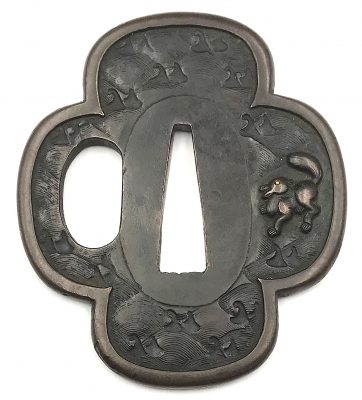
TSU-0282: Ko-kinko yamagane tsuba with waves and rabbit motif.
-
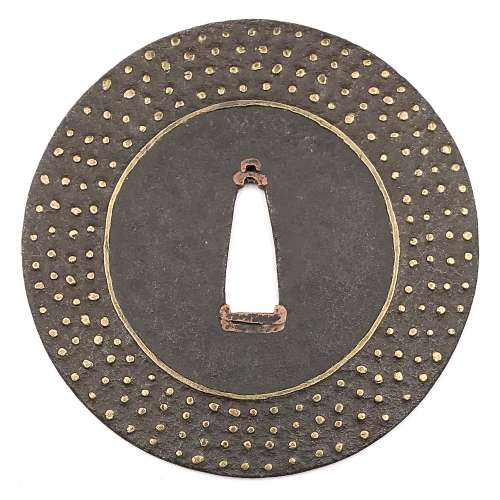 Iron tsuba of round form decorated with inlay of four concentric rows of brass dots or nail heads (ten-zōgan) and a circular brass wire inlay inside the innermost row of dots. Copper sekigane. Muromachi period, 15th or 16th century. Unsigned. Ōnin school. Size: 87.9 x 87.8 x 2.2 mm. Ōnin school got its name from the Ōnin War (応仁の乱 - Ōnin no Ran) - a civil war that lasted 10 years (1467–1477) during the Muromachi period in Japan.
Iron tsuba of round form decorated with inlay of four concentric rows of brass dots or nail heads (ten-zōgan) and a circular brass wire inlay inside the innermost row of dots. Copper sekigane. Muromachi period, 15th or 16th century. Unsigned. Ōnin school. Size: 87.9 x 87.8 x 2.2 mm. Ōnin school got its name from the Ōnin War (応仁の乱 - Ōnin no Ran) - a civil war that lasted 10 years (1467–1477) during the Muromachi period in Japan. -
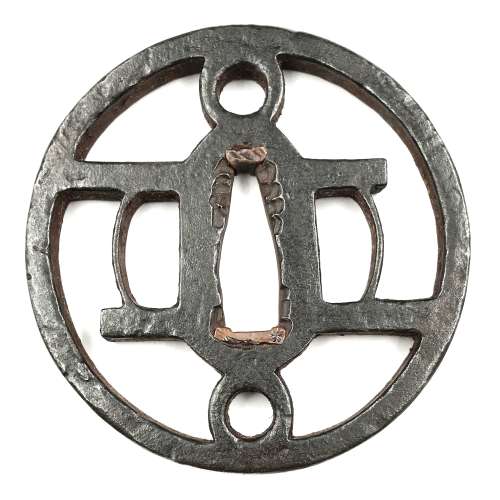 Iron tsuba of round form with design of two parallel crossbars and two rings in openwork (sukashi). Rounded square rim. Moderate iron bones (tekkotsu) allover. Copper sekigane. Kanayama school. Momoyama period (or late Muromachi). Size: 74.5 x 74.0 x 5.5 mm. The rings possibly represent the sun and the moon, or the stars. The parallel crossbars may represent the "two stripes" (futatsu biki) family crest (incl. Ashikaga family).
Iron tsuba of round form with design of two parallel crossbars and two rings in openwork (sukashi). Rounded square rim. Moderate iron bones (tekkotsu) allover. Copper sekigane. Kanayama school. Momoyama period (or late Muromachi). Size: 74.5 x 74.0 x 5.5 mm. The rings possibly represent the sun and the moon, or the stars. The parallel crossbars may represent the "two stripes" (futatsu biki) family crest (incl. Ashikaga family). -
 Iron tsuba of round form with design of two paper lanterns in openwork (small cut-outs, ko-sukashi ) outlined with brass wire. The plate is decorated with four concentric rows of brass dot inlay (ten-zōgan), with a brass circular wire inside the innermost row of dots (missing on the back). Hitsu-ana of rectangular form is not outlined with brass wire, which let us suppose that it was cut out at a later date. Copper sekigane. Mid Muromachi period (1454-1513). Diameter: 74.0 mm, thickness: 2.6 mm. Tsuba is illustrated at: 新版 日本刀講座 小道具鑑定編 本間 薫山 佐藤 寒山 : Shinhan Nihonto Koza, Volume VI, Kodogu Part 1. Under supervision of Honma Kunzan and Sato Kanzan. 鍔 無名 応仁 鉄地) 丸形 小透 槌目 真鍮据文 点象嵌 丸耳 : Tsuba with no signature, Ōnin style. Base metal iron (jigane), round shape, small perforations (ko-sukashi), hammering finish (tsuchime). Pre-cast brass inlay (shinchu suemon-zōgan); dot inlay (ten-zōgan); round edge (maru-mimi).
Iron tsuba of round form with design of two paper lanterns in openwork (small cut-outs, ko-sukashi ) outlined with brass wire. The plate is decorated with four concentric rows of brass dot inlay (ten-zōgan), with a brass circular wire inside the innermost row of dots (missing on the back). Hitsu-ana of rectangular form is not outlined with brass wire, which let us suppose that it was cut out at a later date. Copper sekigane. Mid Muromachi period (1454-1513). Diameter: 74.0 mm, thickness: 2.6 mm. Tsuba is illustrated at: 新版 日本刀講座 小道具鑑定編 本間 薫山 佐藤 寒山 : Shinhan Nihonto Koza, Volume VI, Kodogu Part 1. Under supervision of Honma Kunzan and Sato Kanzan. 鍔 無名 応仁 鉄地) 丸形 小透 槌目 真鍮据文 点象嵌 丸耳 : Tsuba with no signature, Ōnin style. Base metal iron (jigane), round shape, small perforations (ko-sukashi), hammering finish (tsuchime). Pre-cast brass inlay (shinchu suemon-zōgan); dot inlay (ten-zōgan); round edge (maru-mimi).
 English translation of the book indicated above Nihon Tō Kōza, Volume VI, Part 1 by Harry Afu Watson, AFU Research Enterprises, Inc., 1993. Tsuba in question illustrated on page 14 and described as follows: " Tsuba mumei Ōnin. Tetsu ji maru gata ko-sukashi tsuchime shitate shinchū suemon ten zogan maru mimi. Brass suemon". My question remains: why such a text is called 'translation' while it looks more like transliteration of romanization?
English translation of the book indicated above Nihon Tō Kōza, Volume VI, Part 1 by Harry Afu Watson, AFU Research Enterprises, Inc., 1993. Tsuba in question illustrated on page 14 and described as follows: " Tsuba mumei Ōnin. Tetsu ji maru gata ko-sukashi tsuchime shitate shinchū suemon ten zogan maru mimi. Brass suemon". My question remains: why such a text is called 'translation' while it looks more like transliteration of romanization? -
 Iron tsuba of oval form with design of a gourd or aubergine vine with fruits, leaves, and blossoms climbing a trellis, and a fence in yellow brass and red copper flat inlay (hira-zōgan); inlay engraved. Two latticed windows represented by openwork (sukashi). The iron web has deep black patina. The seller attributes this tsuba to Heianjo-Namban school, whatever it means. Momoyama or early Edo period, 17th century. Kaga or Heianjō School. Unsigned. Height: 77.3, Width: 73.1, Thickness at seppa-dai: 3.6 mm.
Iron tsuba of oval form with design of a gourd or aubergine vine with fruits, leaves, and blossoms climbing a trellis, and a fence in yellow brass and red copper flat inlay (hira-zōgan); inlay engraved. Two latticed windows represented by openwork (sukashi). The iron web has deep black patina. The seller attributes this tsuba to Heianjo-Namban school, whatever it means. Momoyama or early Edo period, 17th century. Kaga or Heianjō School. Unsigned. Height: 77.3, Width: 73.1, Thickness at seppa-dai: 3.6 mm.


